Home / Disubstituted Benzenes: The Strongest Electron-Donor “Wins”
Reactions of Aromatic Molecules
Disubstituted Benzenes: The Strongest Electron-Donor “Wins”
Last updated: August 13th, 2024 |
Having gone through the mechanism of electrophilic aromatic substitution, explored activating and deactivating substituents, and seen the importance of directing groups, let’s now take the opportunity to use these concepts to answer some slightly thornier questions.
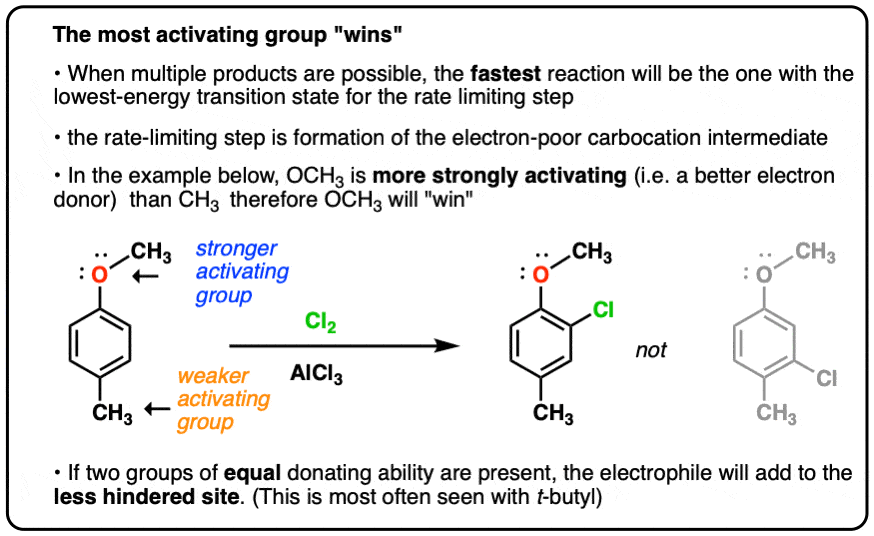
Table of Contents
- Electrophilic Aromatic Substitution With Two Directing Groups: Which Group “Wins” ?
- An Easy One: p-Nitroanisole
- When Two Or More Substituents Are Present, The Directing Group Will Be The Most Activating Substituent.
- If Attack At Two Or More Positions Is Possible, Pick The Least Sterically Hindered One
- Nothing Says “Steric Effects” Quite Like A t-Butyl Group
- Summary: Electrophilic Aromatic Substitution on Disubstituted Benzenes
- Notes
- Quiz Yourself!
- (Advanced) References and Further Reading
1. Electrophilic Aromatic Substitution With Two Directing Groups: Which Group “Wins” ?
Here’s a thorny question: What happens when we perform an electrophilic aromatic substitution reaction when there are two substituents on benzene?
And say that one of them is an ortho-, para- director and one is a meta- director, and they “direct” electrophiles to different carbons on the ring?
Which directing group “wins?”.
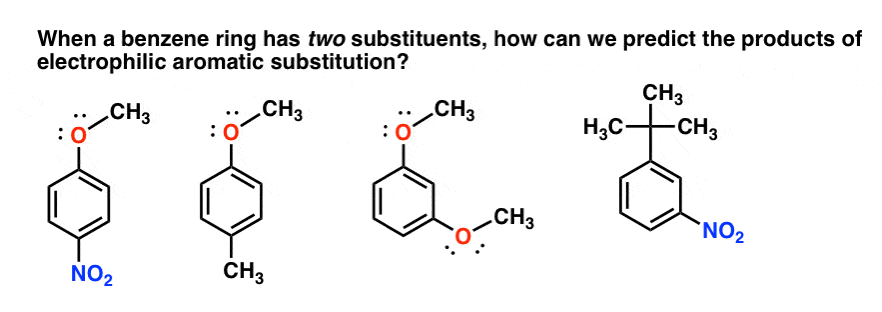
2. An Easy One: p-Nitroanisole
Let’s start with 1-methoxy-4-nitrobenzene, which also goes by the name, p-nitroanisole. Say we try to perform an electrophilic aromatic substitution reaction. Where does the electrophile react? What’s the directing group, OCH3 or NO2 ?
[Note that I’ve used “chlorination” as an example of an electrophilic aromatic substitution reaction, but the principles we will learn in this post apply to all electrophilic aromatic substitution reactions].
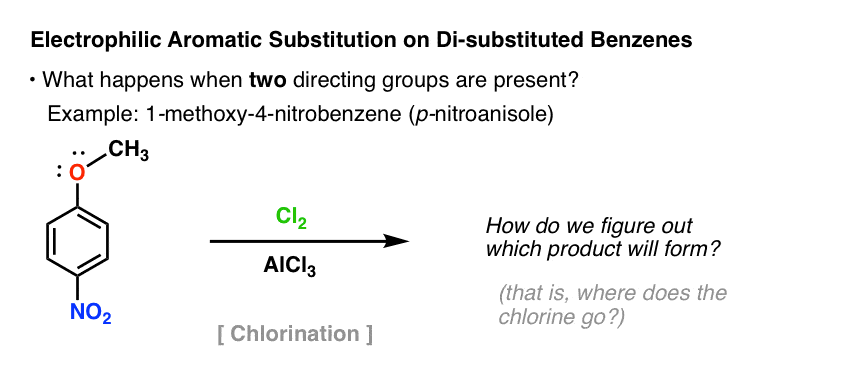
The first thing to do is to analyze each substituent individually.
- The –OCH3 is an ortho-,para- director, but since the para- position is already substituted (with NO2), only the ortho- positions are available.
- The –NO2 is a meta- director, and the positions meta- to the NO2 happen to also be the positions ortho- to the OCH3.
As it turns out, both substituents direct to the same position (C–2). This gives us the product 2-chloro-1-methoxy-4-nitrobenzene, which indeed is the major product. [Note 1]
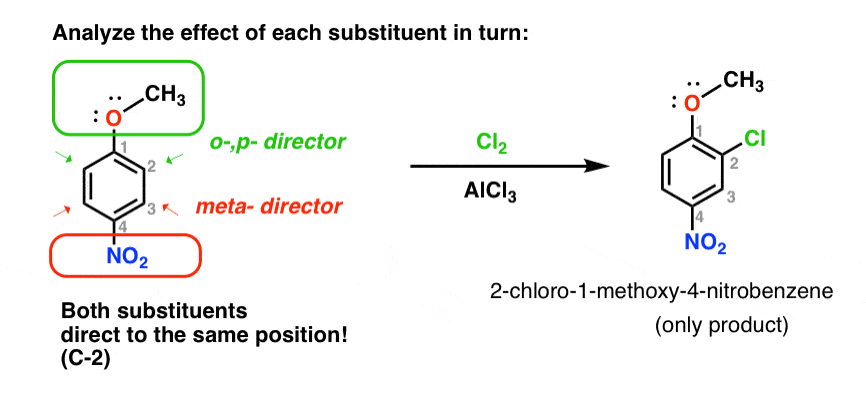
3. When Two Or More Substituents Are Present, The Directing Group Will Be The Most Activating Substituent.
That example was a little too easy. Let’s look at a slightly more ambiguous example: p-methylanisole. Here there are two o-, p- directors: –OCH3 and –CH3.
The tricky part is that they each direct to different carbons. So which substituent “wins” here?
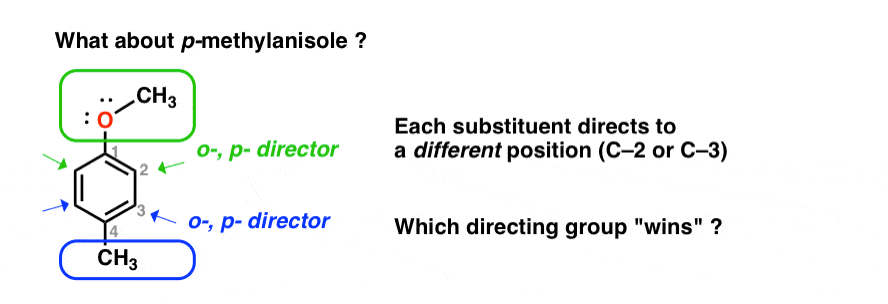
Here’s a good rule of thumb:
Rule #1: When two or more substituents are present on an aromatic ring, the directing group will be the most activating substituent.
(that is, the more activating substituent “wins”)
Here is a useful (but not comprehensive) ranking of activating / deactivating groups:
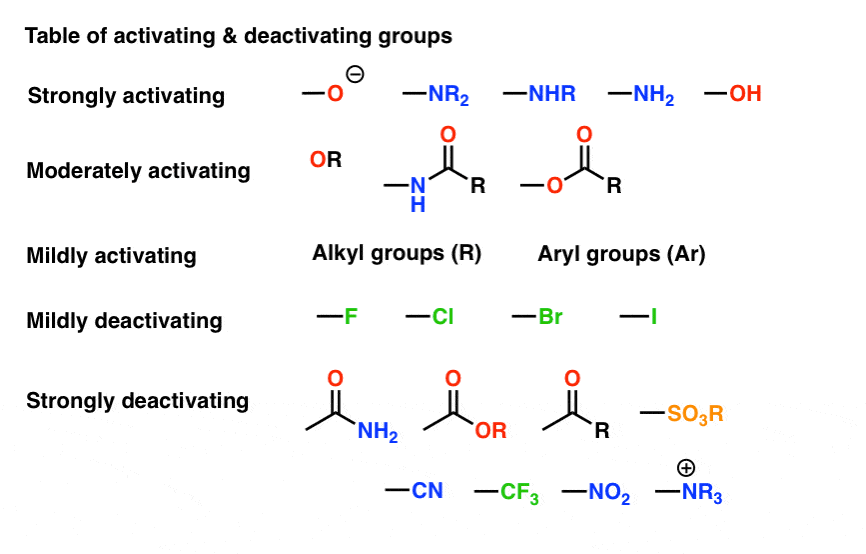
Since OCH3 is a more activating substituent than CH3 (i.e. OCH3 accelerates the rate more, because it is a better electron-donor), the substituent will end up ortho to the OCH3, not ortho to CH3.
A more technical way of describing our rule is: since the rate determining step in electrophilic aromatic substitution is formation of the (electron-poor) carbocation intermediate, the substituent which is most electron-donating will result in the lowest-energy transition state and therefore the lowest activation energy, and therefore will determine the major product.
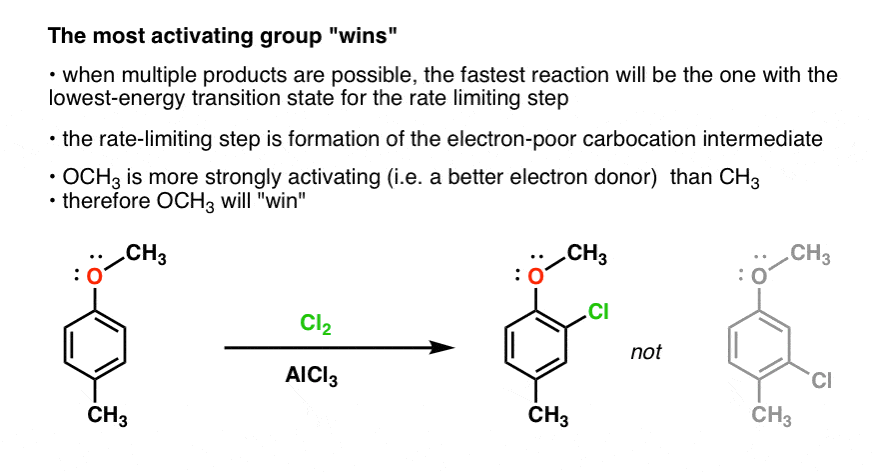
4. If Attack At Two Or More Positions Is Possible, Pick The Least Sterically Hindered One
Here’s another disubstituted example. m-dimethoxybenzene has two identical groups, both of which are ortho-, para- directors.
When we analyze the influence of the directing groups, we again see that their directing effects are additive. Attack at three positions is “favored”: C-2 (in between the two methoxy groups), C-4, and C-6.
As it turns out, attack at C-4 / C-6 will result in the same product, so we really have only two reasonable products to consider.
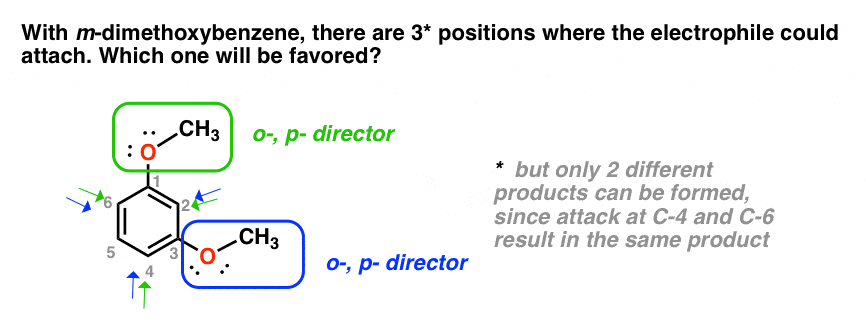
Which of the two products will dominate?
Attack at C-2, C-4, and C-6 is equally favorable from an electronic standpoint (that is, they are all equally electron-rich). However, they are not equally favorable from a steric standpoint.
The C-2 carbon is flanked by two methoxy groups, while the C-4 and C-6 carbons are adjacent only to one. Attack at C-2 will be much slower owing to to this greater steric hindrance.
Here comes the second important rule of thumb:
Rule #2: When attack at two or more electronically equivalent sites is possible, the electrophile will favor the position flanked by the fewest number of substituents.
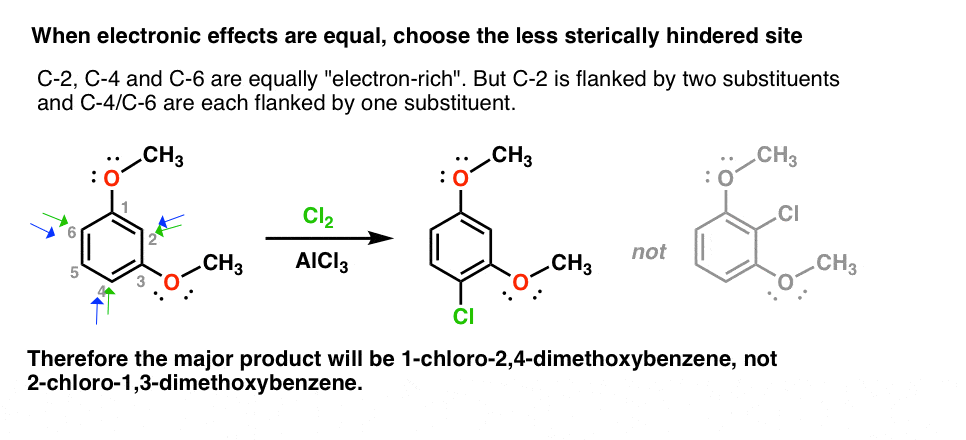
You might recall that we observed this effect previously in electrophilic aromatic substitution reactions of mono-substituted benzene derivatives like methoxybenzene. Even though there are two available ortho- positions, the para- is the major product because it’s less sterically hindered!
5. Nothing Says “Steric Effects” Like A t-Butyl Group
Let’s finish with a last example that lets us tie these examples together. 1-t-butyl-3-nitrobenzene.
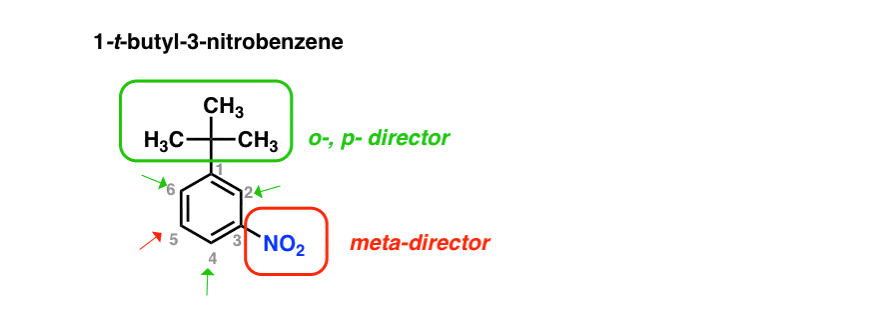
Here we again have a situation where two groups direct to different positions.
What’s a stronger activating group, t-butyl or nitro? (hint : the answer to a question like this is almost never “nitro” : – ) ) . This would suggest that substitution would occur at C-2, C-4, and/or C-6.
Which of these three positions is flanked by the fewest substitutents? Clearly, C-2 is out, being flanked by two groups. This leaves us with C-6 and C-4, which are each flanked by a single group.
However, nothing says “STERIC EFFECTS” quite like a t-butyl group. In this case, C-6 is adjacent to the hugely bulky t-butyl group while attack at C-4 is adjacent to the relatively small NO2 group. So in this case, we’d expect to obtain only one major product.
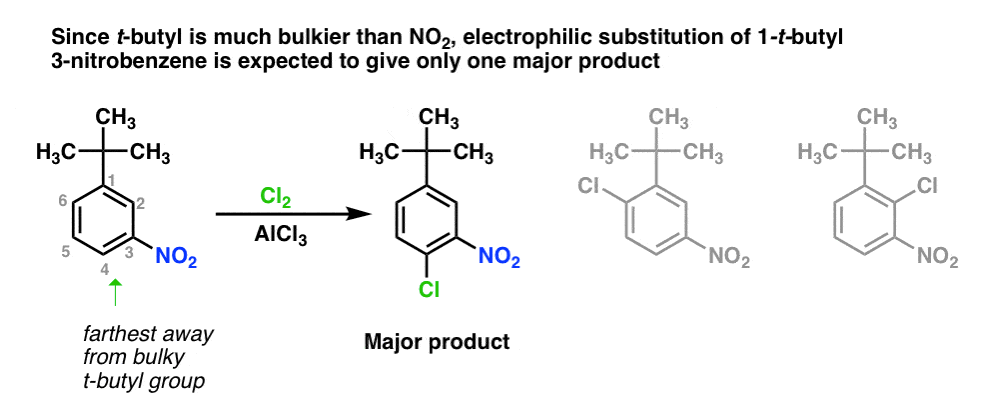
6. Summary: Electrophilic Aromatic Substitution on Disubstituted Benzenes
When faced with trying to predict the product of an electrophilic aromatic substitution reaction of a disubstituted benzene, there are two important rules of thumb:
- The most activating group will act as the directing group.
- Among positions that are similarly “electronically favored”, the site with the fewest adjacent substituents is more likely to be the site of attack.
(Or, as a wag might describe it, it all boils down to “electronics” and “sterics”).
One can apply these two principles to a large variety of commonly encountered situations.
In the next series of posts, we’ll go through some key electrophilic aromatic substitution reactions in detail. Next up: halogenation.
Notes
Related Articles
- Electrophilic Aromatic Substitution: Introduction
- Electrophilic Aromatic Substitution – The Mechanism
- Electrophilic Aromatic Substitutions (1) – Halogenation of Benzene
- Electrophilic Aromatic Substitutions (2) – Nitration and Sulfonation
- EAS Reactions (3) – Friedel-Crafts Acylation and Friedel-Crafts Alkylation
- Electrophilic Aromatic Substitution Practice Problems (MOC Membership)
Note 1. Note that this “addition” of directing group effects will be observed any time there is an “ortho” or “para” relationship between an ortho,para– director and a meta– director.
Note 2. Although an example with two meta- directors wasn’t included, the same principles apply. One has to look at a table that ranks substituents in detailed order of deactivating ability (esters are less deactivating than nitro groups, for example, and would “win” in a competition experiment). One of the complications here is that when there are too many deactivating groups on the benzene ring, certain electrophilic aromatic substitution reactions stop working altogether since the aromatic ring isn’t nucleophilic enough (Friedel-Crafts reactions are in that category)
Note 3. [Advanced]. Not covered here is the ortho- effect. When a meta-directing group is meta to an ortho-para directing group, the incoming group primarily goes ortho- to the meta- directing group rather than para-. For example, with 1-chloro-3-nitrobenzene, one might expect that two products are formed in roughly equal amounts (perhaps even a bit more of 1,2-dichloro-4-nitrobenzene, since Cl is less sterically demanding than NO2 (A values: 0.43 for Cl, 1.1 for NO2).
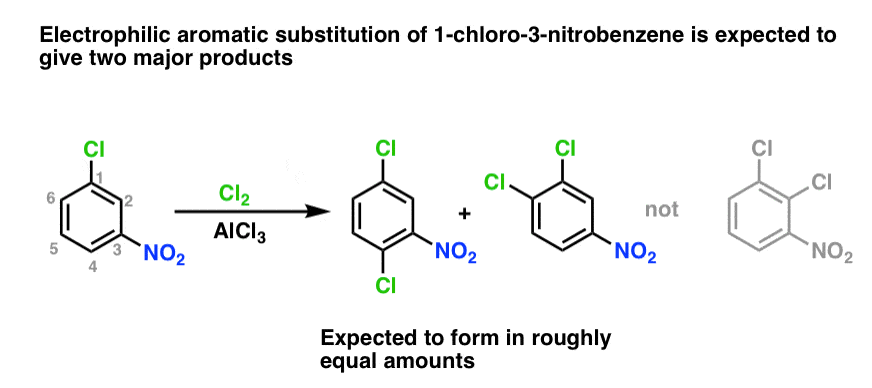
In fact the dominant product is 1,4-dichloro-2-nitrobenzene, and almost no 1,2-dichloro-4-nitrobenzene is formed. The reason is not well understood but is likely due to be through intramolecular assistance from the meta-directing group. [See March’s Advanced Organic Chemistry 5th ed. p. 688 and references therein. ]
Quiz Yourself!
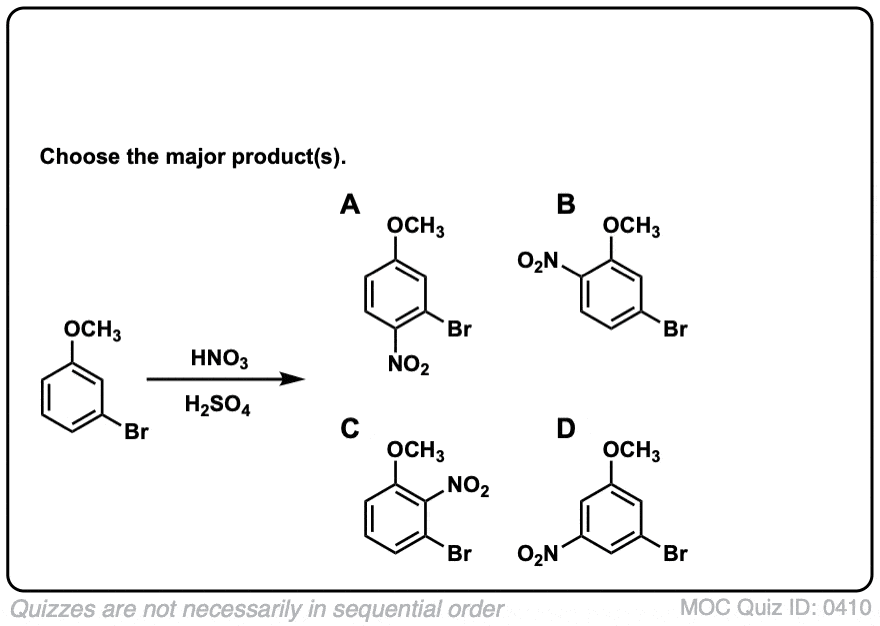 Click to Flip
Click to Flip
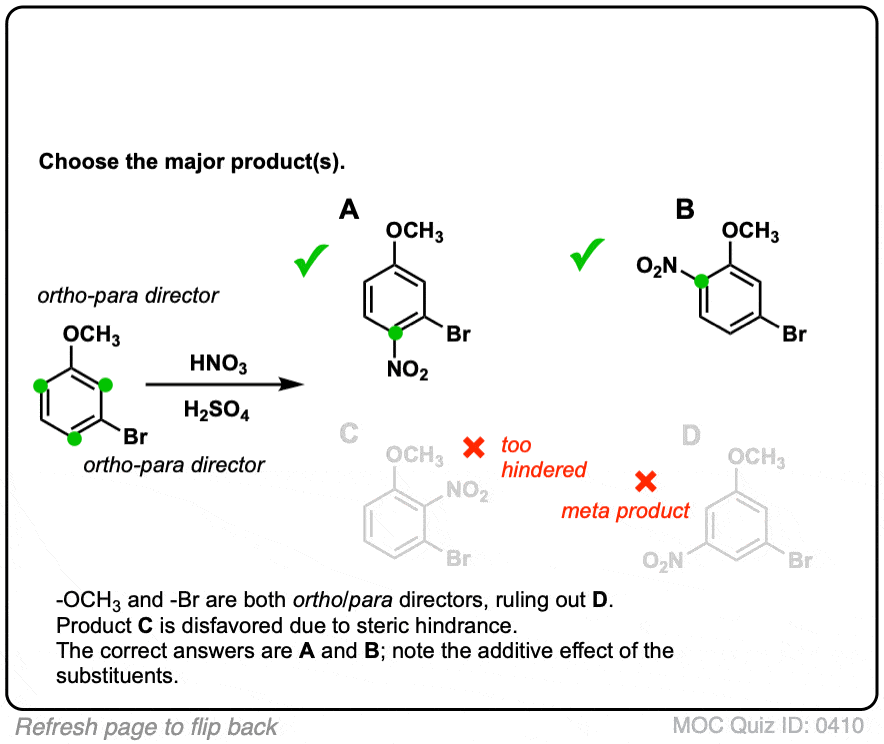
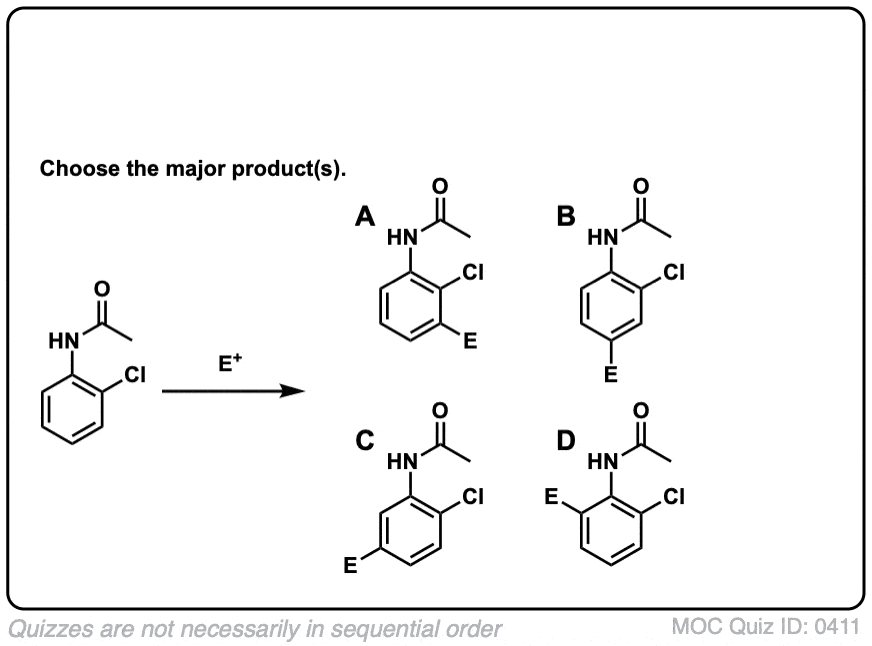 Click to Flip
Click to Flip
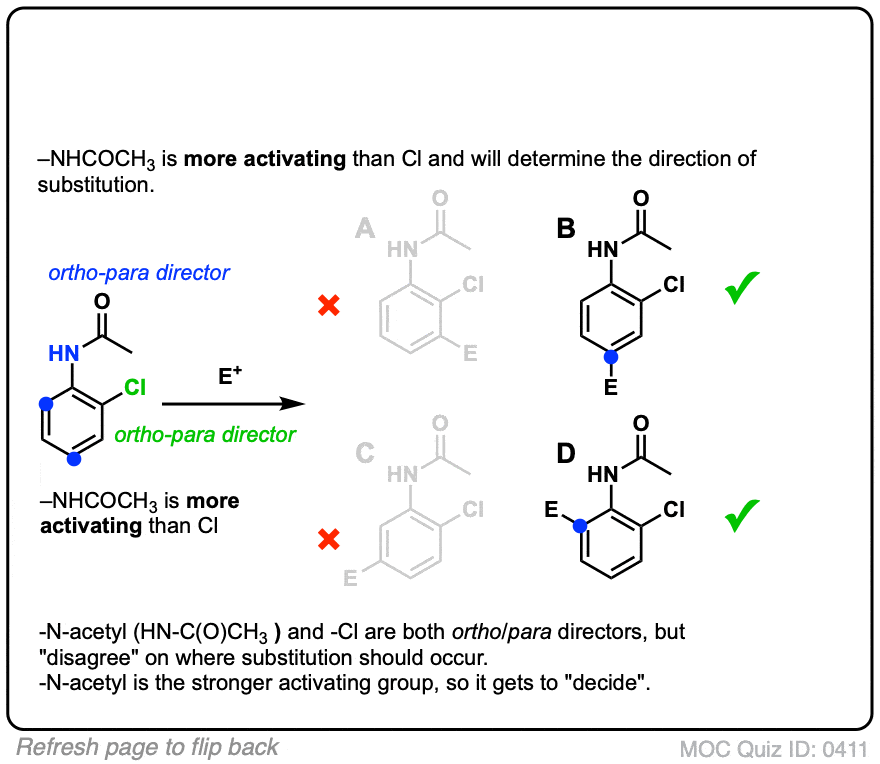
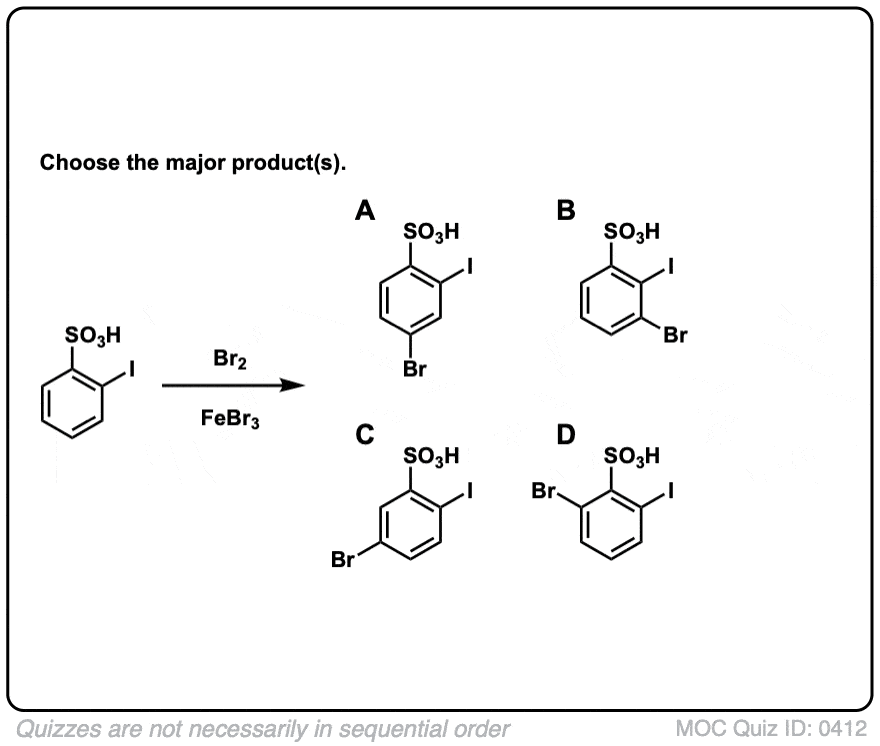 Click to Flip
Click to Flip
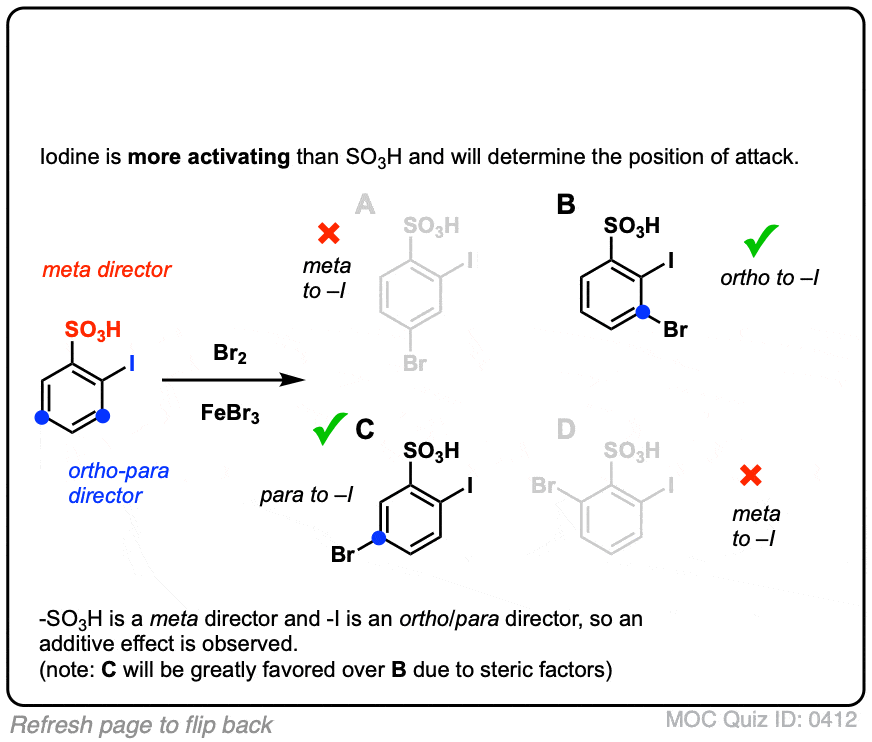
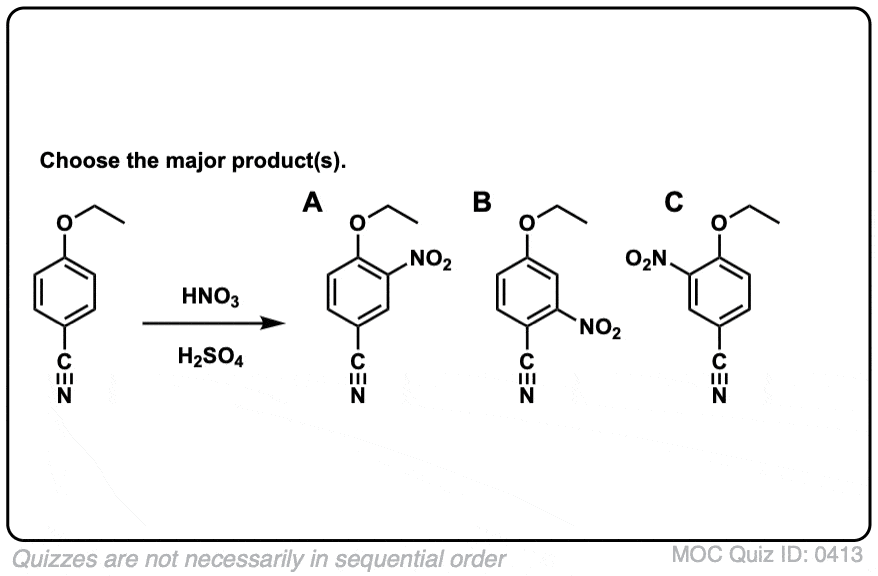 Click to Flip
Click to Flip
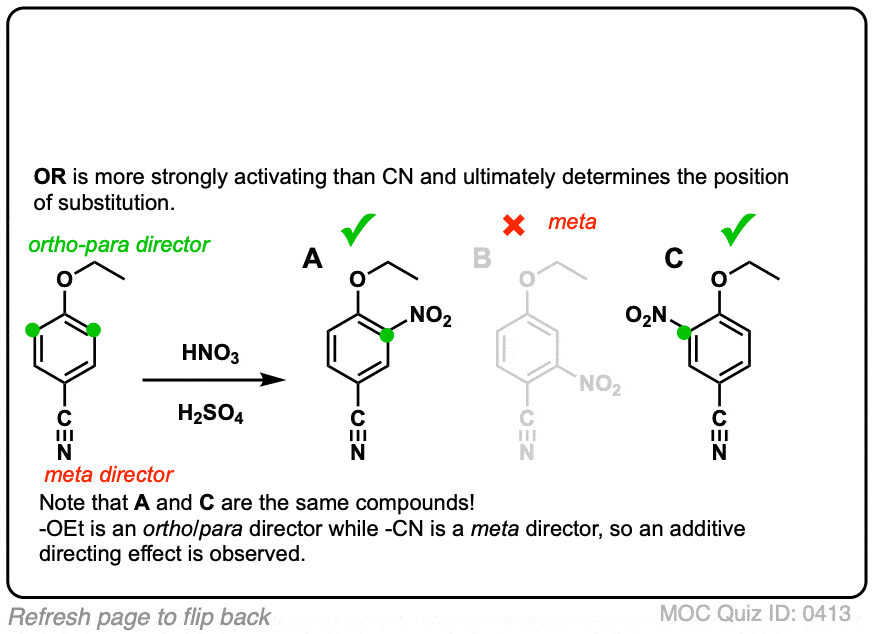
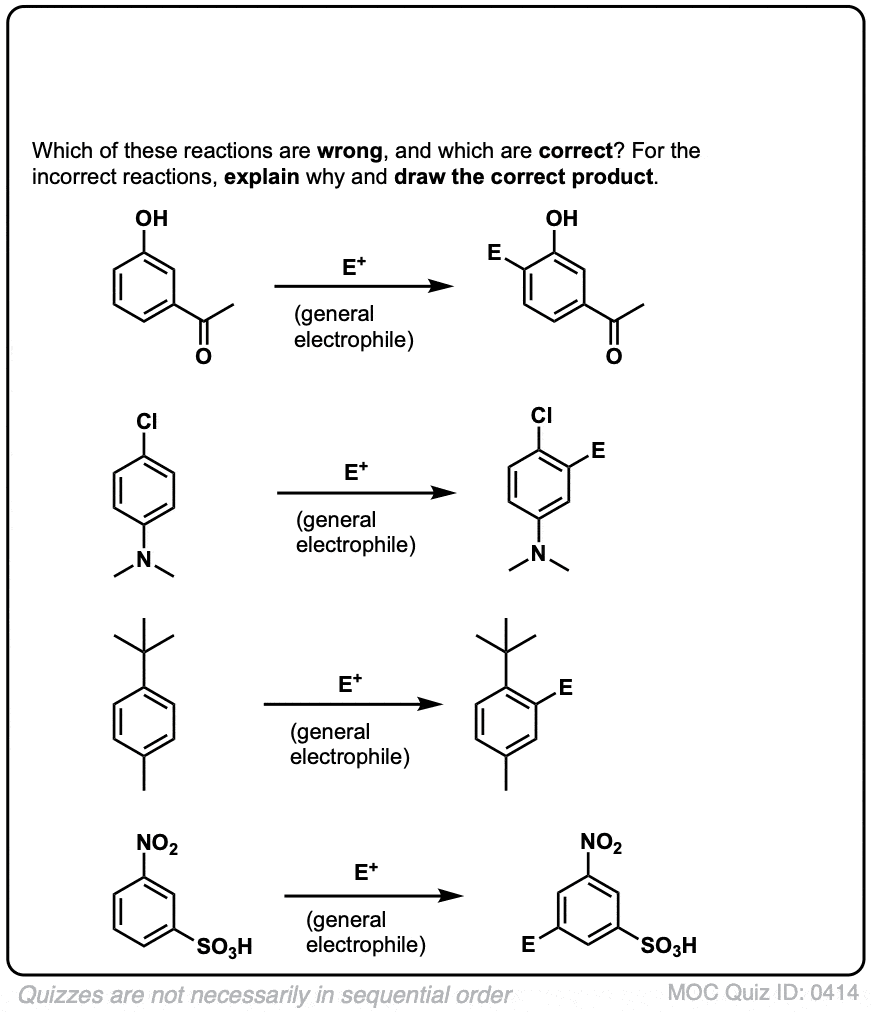 Click to Flip
Click to Flip
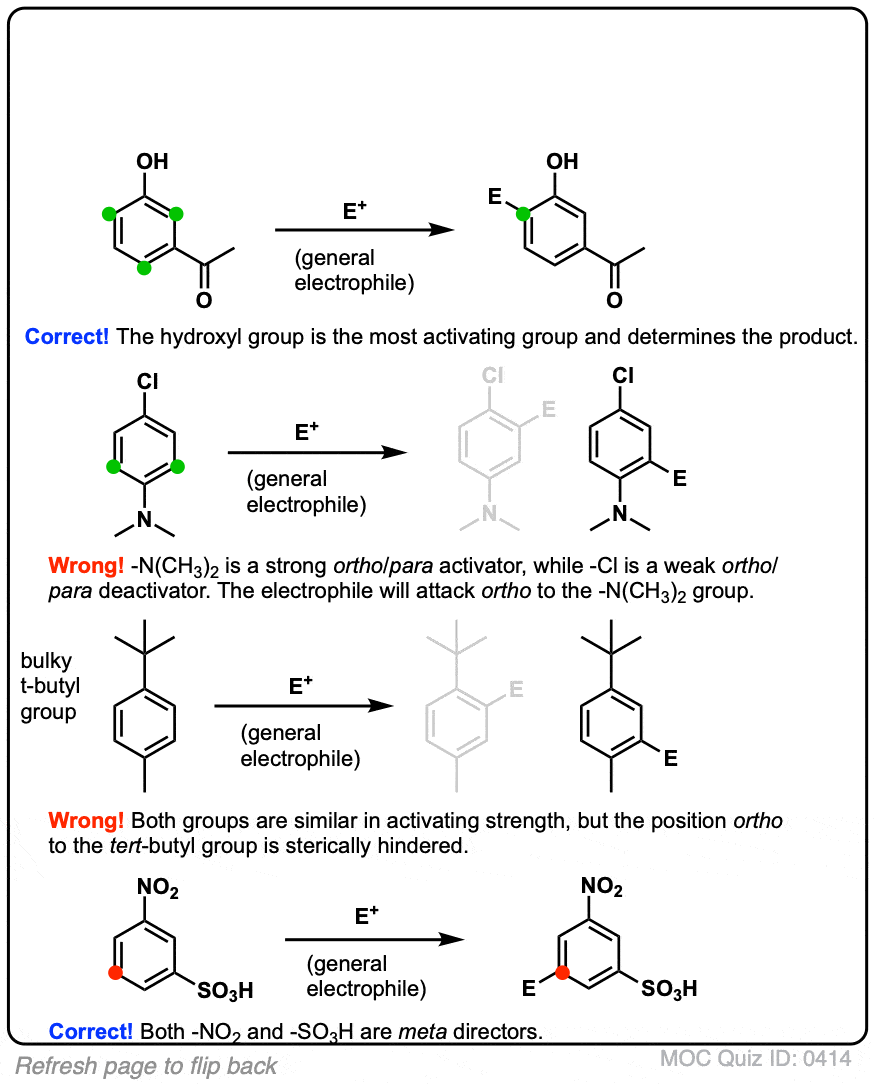
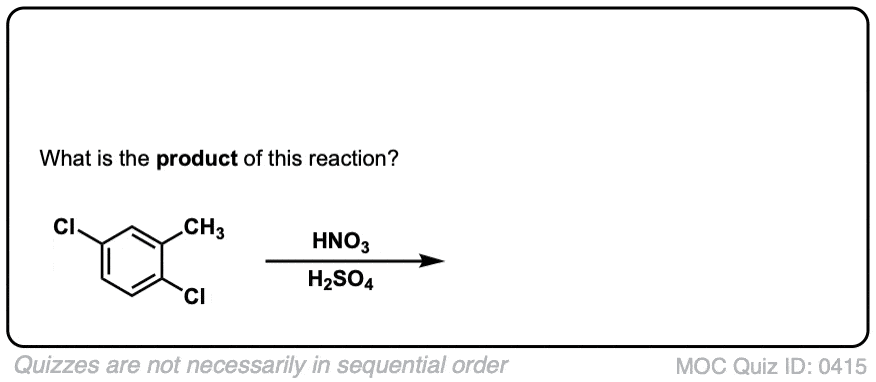 Click to Flip
Click to Flip
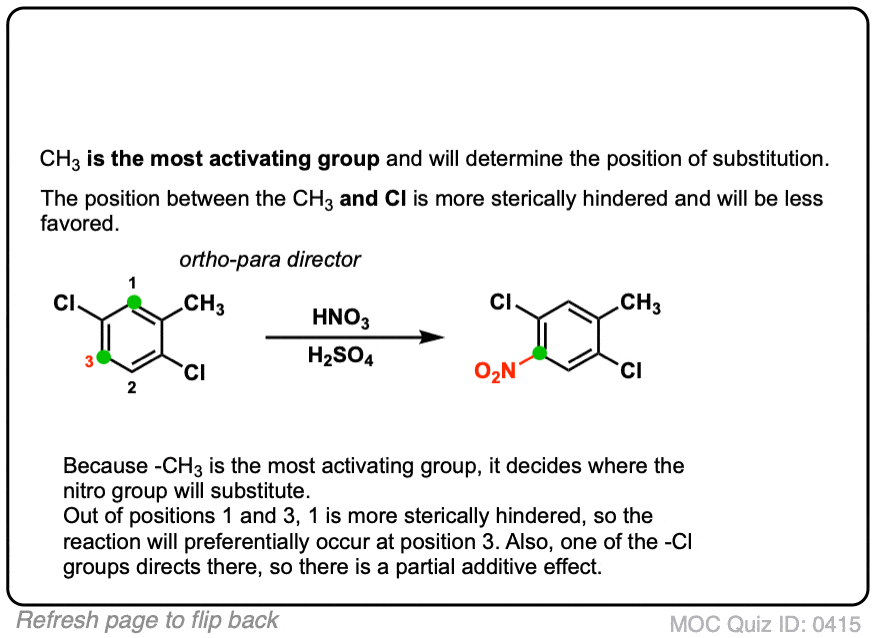
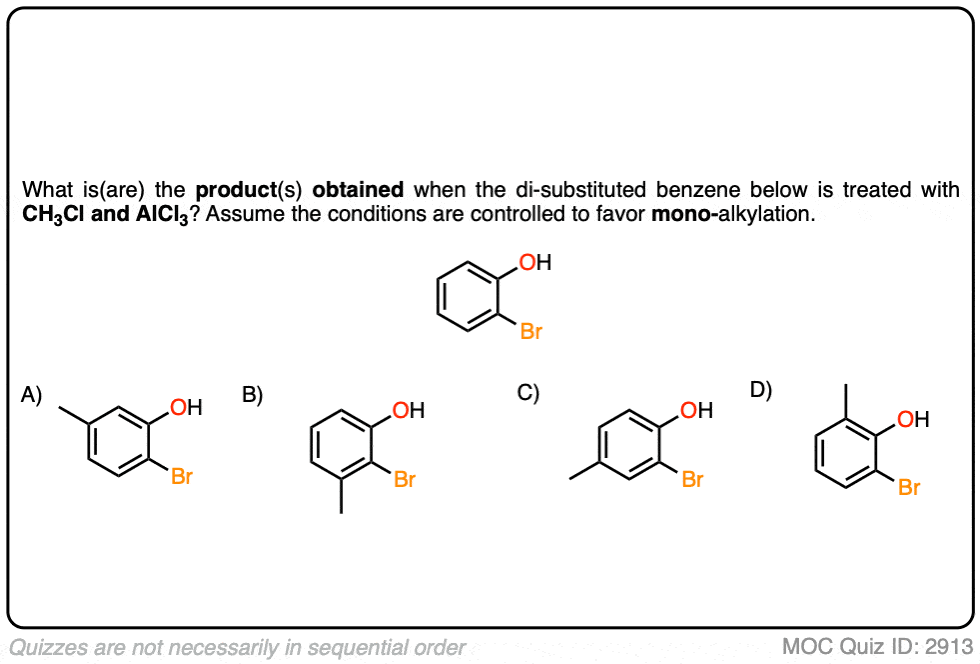 Click to Flip
Click to Flip
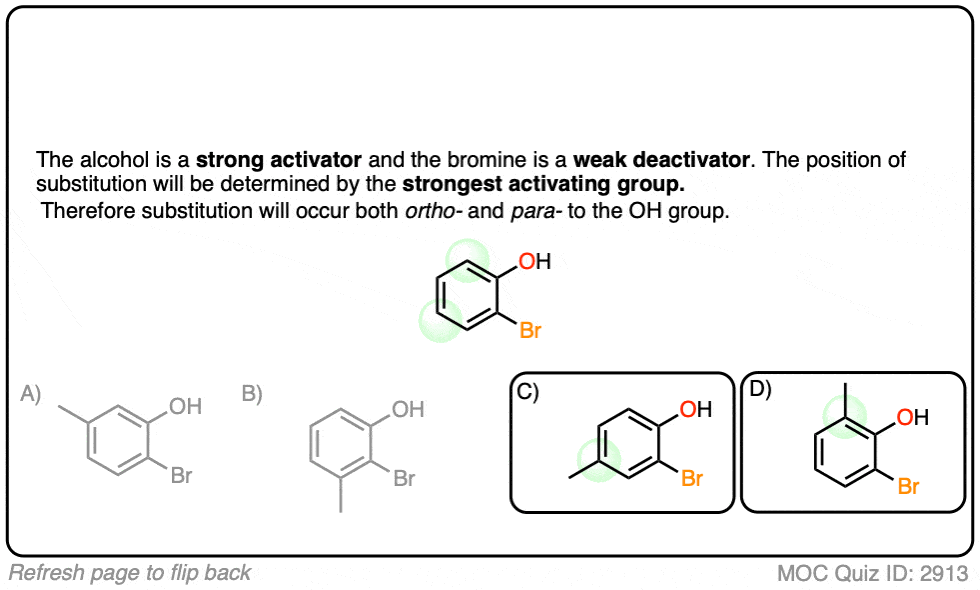
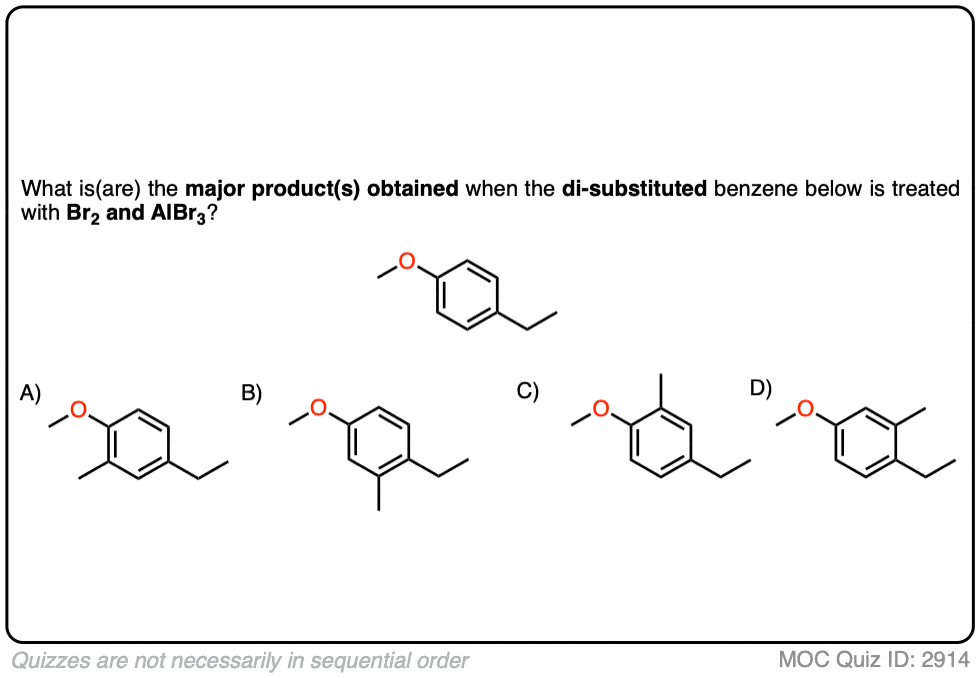 Click to Flip
Click to Flip
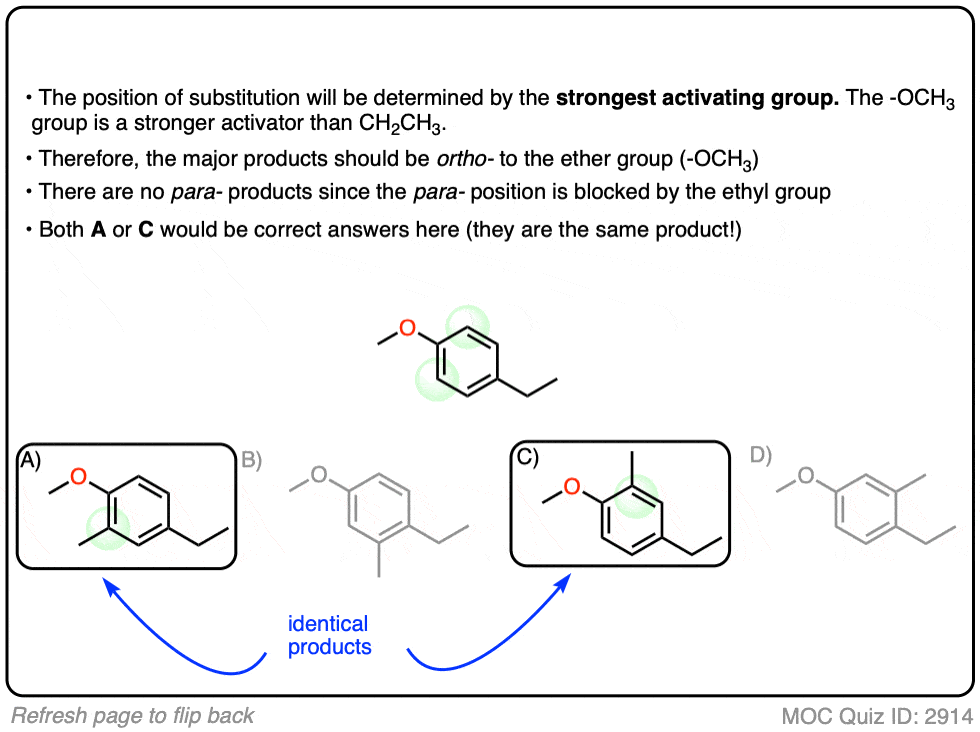
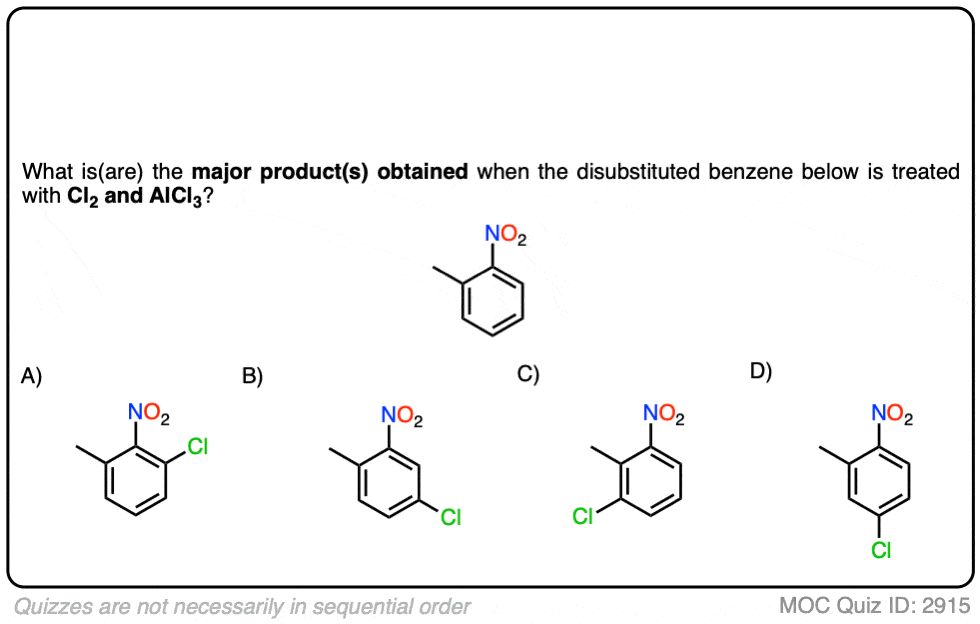 Click to Flip
Click to Flip
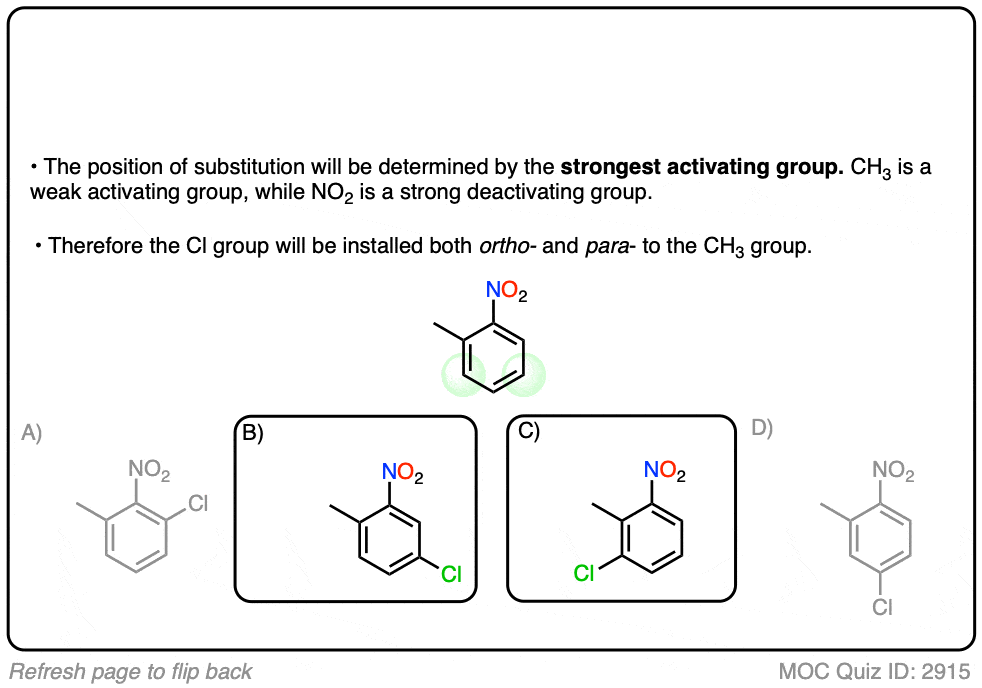
(Advanced) References and Further Reading
- —The nature of the alternating effect in carbon chains. Part V. A discussion of aromatic substitution with special reference to the respective roles of polar and non-polar dissociation; and a further study of the relative directive efficiencies of oxygen and nitrogen
Christopher Kelk Ingold and Edith Hilda Ingold
J. Chem. Soc. 1926, 1310-1328
DOI: 10.1039/JR9262901310
An early paper examining the directing effects of 2 substituents on a benzene ring, in this case -OMe and -NHAc. - —The nature of the alternating effect in carbon chains. Part VI. A study of the relative directive efficiencies of oxygen and fluorine in aromatic substitution
Eric Leighton Holmes and Christopher Kelk Ingold
J. Chem. Soc. 1926, 1328-1333
DOI: 10.1039/JR9262901328
This paper discusses the product distribution obtained upon nitration of o-fluoroanisole. The nitration occurs either ortho to the -OMe (66%) or para to -OMe (31%). - —The nature of the alternating effect in carbon chains. Part XXIII. Anomalous orientation by halogens, and its bearing on the problem of the ortho–para ratio, in aromatic substitution
Christopher Kelk Ingold and Charles Cyril Norrey Vass
J. Chem. Soc. 1928, 417-425
DOI: 10.1039/JR9280000417
This paper discusses directing effects in 1,2-dihalobenzenes. - Volume effects of alkyl groups in aromatic compounds. Part V. The monosulphonation of p-cymene
R. J. W. Le Fèvre
J. Chem. Soc. 1934, 1501-1502
DOI: 10.1039/JR9340001501
In p-cymene, the major product obtained upon electrophilic sulfonation is the 2-product (ortho to the methyl group), likely due to sterics. - Effects of Alkyl Groups in Electrophilic Additions and Substitutions
COHN, H., HUGHES, E., JONES, M. and PEELING, M. G.
Nature 1952, 169, 291
DOI: 1038/169291a0
This paper has data comparing the nitration of t-butylbenzene and toluene. T-butylbenzene is much more p-directing than toluene (79.5% para for t-butylbenzene vs. 40% para for toluene), which is likely due to sterics (ortho approach is blocked by the bulkier t-butyl group). - Distribution of Isomers in the Mononitration of Ethyl- and Isopropylbenzene. Further Evidence for a Steric Effect in Isomer Distribution
Herbert C. Brown and W. Hallam Bonner
Journal of the American Chemical Society 1954, 76 (2), 605-606
DOI: 10.1021/ja01631a084
Table II in this paper illustrates that the ortho product obtained from nitration of monoalkylbenzenes decreases as the alkyl group gets larger (e.g. t-butylbenzene yields very little ortho product upon nitration compared to toluene). - Some aspects of the nitration of the mononitrotoluenes
J. G. Tillett
J. Chem. Soc. 1962, 5142-5148
DOI: 10.1039/JR9620005142
In this paper the rates for nitration of all three nitrotoluenes are measured and compared. The major product for nitration of m-nitrotoluene is 3,4-dinitrotoluene, consistent with the strongest donor (ortho-para directing methyl) “winning” over the (meta-directing) nitro group. Note that nitration of 2,4- or 2,6-nitrotoluene leads to the common explosive 2,4,6-trinitrotoluene (TNT)!
00 General Chemistry Review
01 Bonding, Structure, and Resonance
- How Do We Know Methane (CH4) Is Tetrahedral?
- Hybrid Orbitals and Hybridization
- How To Determine Hybridization: A Shortcut
- Orbital Hybridization And Bond Strengths
- Sigma bonds come in six varieties: Pi bonds come in one
- A Key Skill: How to Calculate Formal Charge
- The Four Intermolecular Forces and How They Affect Boiling Points
- 3 Trends That Affect Boiling Points
- How To Use Electronegativity To Determine Electron Density (and why NOT to trust formal charge)
- Introduction to Resonance
- How To Use Curved Arrows To Interchange Resonance Forms
- Evaluating Resonance Forms (1) - The Rule of Least Charges
- How To Find The Best Resonance Structure By Applying Electronegativity
- Evaluating Resonance Structures With Negative Charges
- Evaluating Resonance Structures With Positive Charge
- Exploring Resonance: Pi-Donation
- Exploring Resonance: Pi-acceptors
- In Summary: Evaluating Resonance Structures
- Drawing Resonance Structures: 3 Common Mistakes To Avoid
- How to apply electronegativity and resonance to understand reactivity
- Bond Hybridization Practice
- Structure and Bonding Practice Quizzes
- Resonance Structures Practice
02 Acid Base Reactions
- Introduction to Acid-Base Reactions
- Acid Base Reactions In Organic Chemistry
- The Stronger The Acid, The Weaker The Conjugate Base
- Walkthrough of Acid-Base Reactions (3) - Acidity Trends
- Five Key Factors That Influence Acidity
- Acid-Base Reactions: Introducing Ka and pKa
- How to Use a pKa Table
- The pKa Table Is Your Friend
- A Handy Rule of Thumb for Acid-Base Reactions
- Acid Base Reactions Are Fast
- pKa Values Span 60 Orders Of Magnitude
- How Protonation and Deprotonation Affect Reactivity
- Acid Base Practice Problems
03 Alkanes and Nomenclature
- Meet the (Most Important) Functional Groups
- Condensed Formulas: Deciphering What the Brackets Mean
- Hidden Hydrogens, Hidden Lone Pairs, Hidden Counterions
- Don't Be Futyl, Learn The Butyls
- Primary, Secondary, Tertiary, Quaternary In Organic Chemistry
- Branching, and Its Affect On Melting and Boiling Points
- The Many, Many Ways of Drawing Butane
- Wedge And Dash Convention For Tetrahedral Carbon
- Common Mistakes in Organic Chemistry: Pentavalent Carbon
- Table of Functional Group Priorities for Nomenclature
- Summary Sheet - Alkane Nomenclature
- Organic Chemistry IUPAC Nomenclature Demystified With A Simple Puzzle Piece Approach
- Boiling Point Quizzes
- Organic Chemistry Nomenclature Quizzes
04 Conformations and Cycloalkanes
- Staggered vs Eclipsed Conformations of Ethane
- Conformational Isomers of Propane
- Newman Projection of Butane (and Gauche Conformation)
- Introduction to Cycloalkanes
- Geometric Isomers In Small Rings: Cis And Trans Cycloalkanes
- Calculation of Ring Strain In Cycloalkanes
- Cycloalkanes - Ring Strain In Cyclopropane And Cyclobutane
- Cyclohexane Conformations
- Cyclohexane Chair Conformation: An Aerial Tour
- How To Draw The Cyclohexane Chair Conformation
- The Cyclohexane Chair Flip
- The Cyclohexane Chair Flip - Energy Diagram
- Substituted Cyclohexanes - Axial vs Equatorial
- Ranking The Bulkiness Of Substituents On Cyclohexanes: "A-Values"
- Cyclohexane Chair Conformation Stability: Which One Is Lower Energy?
- Fused Rings - Cis-Decalin and Trans-Decalin
- Naming Bicyclic Compounds - Fused, Bridged, and Spiro
- Bredt's Rule (And Summary of Cycloalkanes)
- Newman Projection Practice
- Cycloalkanes Practice Problems
05 A Primer On Organic Reactions
- The Most Important Question To Ask When Learning a New Reaction
- Curved Arrows (for reactions)
- Nucleophiles and Electrophiles
- The Three Classes of Nucleophiles
- Nucleophilicity vs. Basicity
- What Makes A Good Nucleophile?
- What Makes A Good Leaving Group?
- 3 Factors That Stabilize Carbocations
- Equilibrium and Energy Relationships
- 7 Factors that stabilize negative charge in organic chemistry
- 7 Factors That Stabilize Positive Charge in Organic Chemistry
- What's a Transition State?
- Hammond's Postulate
- Learning Organic Chemistry Reactions: A Checklist (PDF)
- Introduction to Oxidative Cleavage Reactions
06 Free Radical Reactions
- Bond Dissociation Energies = Homolytic Cleavage
- Free Radical Reactions
- 3 Factors That Stabilize Free Radicals
- What Factors Destabilize Free Radicals?
- Bond Strengths And Radical Stability
- Free Radical Initiation: Why Is "Light" Or "Heat" Required?
- Initiation, Propagation, Termination
- Monochlorination Products Of Propane, Pentane, And Other Alkanes
- Selectivity In Free Radical Reactions
- Selectivity in Free Radical Reactions: Bromination vs. Chlorination
- Halogenation At Tiffany's
- Allylic Bromination
- Bonus Topic: Allylic Rearrangements
- In Summary: Free Radicals
- Synthesis (2) - Reactions of Alkanes
- Free Radicals Practice Quizzes
07 Stereochemistry and Chirality
- Types of Isomers: Constitutional Isomers, Stereoisomers, Enantiomers, and Diastereomers
- How To Draw The Enantiomer Of A Chiral Molecule
- How To Draw A Bond Rotation
- Introduction to Assigning (R) and (S): The Cahn-Ingold-Prelog Rules
- Assigning Cahn-Ingold-Prelog (CIP) Priorities (2) - The Method of Dots
- Enantiomers vs Diastereomers vs The Same? Two Methods For Solving Problems
- Assigning R/S To Newman Projections (And Converting Newman To Line Diagrams)
- How To Determine R and S Configurations On A Fischer Projection
- The Meso Trap
- Optical Rotation, Optical Activity, and Specific Rotation
- Optical Purity and Enantiomeric Excess
- What's a Racemic Mixture?
- Chiral Allenes And Chiral Axes
- Stereochemistry Practice Problems and Quizzes
08 Substitution Reactions
- Nucleophilic Substitution Reactions - Introduction
- Two Types of Nucleophilic Substitution Reactions
- The SN2 Mechanism
- Why the SN2 Reaction Is Powerful
- The SN1 Mechanism
- The Conjugate Acid Is A Better Leaving Group
- Comparing the SN1 and SN2 Reactions
- Polar Protic? Polar Aprotic? Nonpolar? All About Solvents
- Steric Hindrance is Like a Fat Goalie
- Common Blind Spot: Intramolecular Reactions
- Substitution Practice - SN1
- Substitution Practice - SN2
09 Elimination Reactions
- Elimination Reactions (1): Introduction And The Key Pattern
- Elimination Reactions (2): The Zaitsev Rule
- Elimination Reactions Are Favored By Heat
- Two Elimination Reaction Patterns
- The E1 Reaction
- The E2 Mechanism
- E1 vs E2: Comparing the E1 and E2 Reactions
- Antiperiplanar Relationships: The E2 Reaction and Cyclohexane Rings
- Bulky Bases in Elimination Reactions
- Comparing the E1 vs SN1 Reactions
- Elimination (E1) Reactions With Rearrangements
- E1cB - Elimination (Unimolecular) Conjugate Base
- Elimination (E1) Practice Problems And Solutions
- Elimination (E2) Practice Problems and Solutions
10 Rearrangements
11 SN1/SN2/E1/E2 Decision
- Identifying Where Substitution and Elimination Reactions Happen
- Deciding SN1/SN2/E1/E2 (1) - The Substrate
- Deciding SN1/SN2/E1/E2 (2) - The Nucleophile/Base
- SN1 vs E1 and SN2 vs E2 : The Temperature
- Deciding SN1/SN2/E1/E2 - The Solvent
- Wrapup: The Key Factors For Determining SN1/SN2/E1/E2
- Alkyl Halide Reaction Map And Summary
- SN1 SN2 E1 E2 Practice Problems
12 Alkene Reactions
- E and Z Notation For Alkenes (+ Cis/Trans)
- Alkene Stability
- Alkene Addition Reactions: "Regioselectivity" and "Stereoselectivity" (Syn/Anti)
- Stereoselective and Stereospecific Reactions
- Hydrohalogenation of Alkenes and Markovnikov's Rule
- Hydration of Alkenes With Aqueous Acid
- Rearrangements in Alkene Addition Reactions
- Halogenation of Alkenes and Halohydrin Formation
- Oxymercuration Demercuration of Alkenes
- Hydroboration Oxidation of Alkenes
- m-CPBA (meta-chloroperoxybenzoic acid)
- OsO4 (Osmium Tetroxide) for Dihydroxylation of Alkenes
- Palladium on Carbon (Pd/C) for Catalytic Hydrogenation of Alkenes
- Cyclopropanation of Alkenes
- A Fourth Alkene Addition Pattern - Free Radical Addition
- Alkene Reactions: Ozonolysis
- Summary: Three Key Families Of Alkene Reaction Mechanisms
- Synthesis (4) - Alkene Reaction Map, Including Alkyl Halide Reactions
- Alkene Reactions Practice Problems
13 Alkyne Reactions
- Acetylides from Alkynes, And Substitution Reactions of Acetylides
- Partial Reduction of Alkynes With Lindlar's Catalyst
- Partial Reduction of Alkynes With Na/NH3 To Obtain Trans Alkenes
- Alkyne Hydroboration With "R2BH"
- Hydration and Oxymercuration of Alkynes
- Hydrohalogenation of Alkynes
- Alkyne Halogenation: Bromination, Chlorination, and Iodination of Alkynes
- Alkyne Reactions - The "Concerted" Pathway
- Alkenes To Alkynes Via Halogenation And Elimination Reactions
- Alkynes Are A Blank Canvas
- Synthesis (5) - Reactions of Alkynes
- Alkyne Reactions Practice Problems With Answers
14 Alcohols, Epoxides and Ethers
- Alcohols - Nomenclature and Properties
- Alcohols Can Act As Acids Or Bases (And Why It Matters)
- Alcohols - Acidity and Basicity
- The Williamson Ether Synthesis
- Ethers From Alkenes, Tertiary Alkyl Halides and Alkoxymercuration
- Alcohols To Ethers via Acid Catalysis
- Cleavage Of Ethers With Acid
- Epoxides - The Outlier Of The Ether Family
- Opening of Epoxides With Acid
- Epoxide Ring Opening With Base
- Making Alkyl Halides From Alcohols
- Tosylates And Mesylates
- PBr3 and SOCl2
- Elimination Reactions of Alcohols
- Elimination of Alcohols To Alkenes With POCl3
- Alcohol Oxidation: "Strong" and "Weak" Oxidants
- Demystifying The Mechanisms of Alcohol Oxidations
- Protecting Groups For Alcohols
- Thiols And Thioethers
- Calculating the oxidation state of a carbon
- Oxidation and Reduction in Organic Chemistry
- Oxidation Ladders
- SOCl2 Mechanism For Alcohols To Alkyl Halides: SN2 versus SNi
- Alcohol Reactions Roadmap (PDF)
- Alcohol Reaction Practice Problems
- Epoxide Reaction Quizzes
- Oxidation and Reduction Practice Quizzes
15 Organometallics
- What's An Organometallic?
- Formation of Grignard and Organolithium Reagents
- Organometallics Are Strong Bases
- Reactions of Grignard Reagents
- Protecting Groups In Grignard Reactions
- Synthesis Problems Involving Grignard Reagents
- Grignard Reactions And Synthesis (2)
- Organocuprates (Gilman Reagents): How They're Made
- Gilman Reagents (Organocuprates): What They're Used For
- The Heck, Suzuki, and Olefin Metathesis Reactions (And Why They Don't Belong In Most Introductory Organic Chemistry Courses)
- Reaction Map: Reactions of Organometallics
- Grignard Practice Problems
16 Spectroscopy
- Degrees of Unsaturation (or IHD, Index of Hydrogen Deficiency)
- Conjugation And Color (+ How Bleach Works)
- Introduction To UV-Vis Spectroscopy
- UV-Vis Spectroscopy: Absorbance of Carbonyls
- UV-Vis Spectroscopy: Practice Questions
- Bond Vibrations, Infrared Spectroscopy, and the "Ball and Spring" Model
- Infrared Spectroscopy: A Quick Primer On Interpreting Spectra
- IR Spectroscopy: 4 Practice Problems
- 1H NMR: How Many Signals?
- Homotopic, Enantiotopic, Diastereotopic
- Diastereotopic Protons in 1H NMR Spectroscopy: Examples
- 13-C NMR - How Many Signals
- Liquid Gold: Pheromones In Doe Urine
- Natural Product Isolation (1) - Extraction
- Natural Product Isolation (2) - Purification Techniques, An Overview
- Structure Determination Case Study: Deer Tarsal Gland Pheromone
17 Dienes and MO Theory
- What To Expect In Organic Chemistry 2
- Are these molecules conjugated?
- Conjugation And Resonance In Organic Chemistry
- Bonding And Antibonding Pi Orbitals
- Molecular Orbitals of The Allyl Cation, Allyl Radical, and Allyl Anion
- Pi Molecular Orbitals of Butadiene
- Reactions of Dienes: 1,2 and 1,4 Addition
- Thermodynamic and Kinetic Products
- More On 1,2 and 1,4 Additions To Dienes
- s-cis and s-trans
- The Diels-Alder Reaction
- Cyclic Dienes and Dienophiles in the Diels-Alder Reaction
- Stereochemistry of the Diels-Alder Reaction
- Exo vs Endo Products In The Diels Alder: How To Tell Them Apart
- HOMO and LUMO In the Diels Alder Reaction
- Why Are Endo vs Exo Products Favored in the Diels-Alder Reaction?
- Diels-Alder Reaction: Kinetic and Thermodynamic Control
- The Retro Diels-Alder Reaction
- The Intramolecular Diels Alder Reaction
- Regiochemistry In The Diels-Alder Reaction
- The Cope and Claisen Rearrangements
- Electrocyclic Reactions
- Electrocyclic Ring Opening And Closure (2) - Six (or Eight) Pi Electrons
- Diels Alder Practice Problems
- Molecular Orbital Theory Practice
18 Aromaticity
- Introduction To Aromaticity
- Rules For Aromaticity
- Huckel's Rule: What Does 4n+2 Mean?
- Aromatic, Non-Aromatic, or Antiaromatic? Some Practice Problems
- Antiaromatic Compounds and Antiaromaticity
- The Pi Molecular Orbitals of Benzene
- The Pi Molecular Orbitals of Cyclobutadiene
- Frost Circles
- Aromaticity Practice Quizzes
19 Reactions of Aromatic Molecules
- Electrophilic Aromatic Substitution: Introduction
- Activating and Deactivating Groups In Electrophilic Aromatic Substitution
- Electrophilic Aromatic Substitution - The Mechanism
- Ortho-, Para- and Meta- Directors in Electrophilic Aromatic Substitution
- Understanding Ortho, Para, and Meta Directors
- Why are halogens ortho- para- directors?
- Disubstituted Benzenes: The Strongest Electron-Donor "Wins"
- Electrophilic Aromatic Substitutions (1) - Halogenation of Benzene
- Electrophilic Aromatic Substitutions (2) - Nitration and Sulfonation
- EAS Reactions (3) - Friedel-Crafts Acylation and Friedel-Crafts Alkylation
- Intramolecular Friedel-Crafts Reactions
- Nucleophilic Aromatic Substitution (NAS)
- Nucleophilic Aromatic Substitution (2) - The Benzyne Mechanism
- Reactions on the "Benzylic" Carbon: Bromination And Oxidation
- The Wolff-Kishner, Clemmensen, And Other Carbonyl Reductions
- More Reactions on the Aromatic Sidechain: Reduction of Nitro Groups and the Baeyer Villiger
- Aromatic Synthesis (1) - "Order Of Operations"
- Synthesis of Benzene Derivatives (2) - Polarity Reversal
- Aromatic Synthesis (3) - Sulfonyl Blocking Groups
- Birch Reduction
- Synthesis (7): Reaction Map of Benzene and Related Aromatic Compounds
- Aromatic Reactions and Synthesis Practice
- Electrophilic Aromatic Substitution Practice Problems
20 Aldehydes and Ketones
- What's The Alpha Carbon In Carbonyl Compounds?
- Nucleophilic Addition To Carbonyls
- Aldehydes and Ketones: 14 Reactions With The Same Mechanism
- Sodium Borohydride (NaBH4) Reduction of Aldehydes and Ketones
- Grignard Reagents For Addition To Aldehydes and Ketones
- Wittig Reaction
- Hydrates, Hemiacetals, and Acetals
- Imines - Properties, Formation, Reactions, and Mechanisms
- All About Enamines
- Breaking Down Carbonyl Reaction Mechanisms: Reactions of Anionic Nucleophiles (Part 2)
- Aldehydes Ketones Reaction Practice
21 Carboxylic Acid Derivatives
- Nucleophilic Acyl Substitution (With Negatively Charged Nucleophiles)
- Addition-Elimination Mechanisms With Neutral Nucleophiles (Including Acid Catalysis)
- Basic Hydrolysis of Esters - Saponification
- Transesterification
- Proton Transfer
- Fischer Esterification - Carboxylic Acid to Ester Under Acidic Conditions
- Lithium Aluminum Hydride (LiAlH4) For Reduction of Carboxylic Acid Derivatives
- LiAlH[Ot-Bu]3 For The Reduction of Acid Halides To Aldehydes
- Di-isobutyl Aluminum Hydride (DIBAL) For The Partial Reduction of Esters and Nitriles
- Amide Hydrolysis
- Thionyl Chloride (SOCl2)
- Diazomethane (CH2N2)
- Carbonyl Chemistry: Learn Six Mechanisms For the Price Of One
- Making Music With Mechanisms (PADPED)
- Carboxylic Acid Derivatives Practice Questions
22 Enols and Enolates
- Keto-Enol Tautomerism
- Enolates - Formation, Stability, and Simple Reactions
- Kinetic Versus Thermodynamic Enolates
- Aldol Addition and Condensation Reactions
- Reactions of Enols - Acid-Catalyzed Aldol, Halogenation, and Mannich Reactions
- Claisen Condensation and Dieckmann Condensation
- Decarboxylation
- The Malonic Ester and Acetoacetic Ester Synthesis
- The Michael Addition Reaction and Conjugate Addition
- The Robinson Annulation
- Haloform Reaction
- The Hell–Volhard–Zelinsky Reaction
- Enols and Enolates Practice Quizzes
23 Amines
- The Amide Functional Group: Properties, Synthesis, and Nomenclature
- Basicity of Amines And pKaH
- 5 Key Basicity Trends of Amines
- The Mesomeric Effect And Aromatic Amines
- Nucleophilicity of Amines
- Alkylation of Amines (Sucks!)
- Reductive Amination
- The Gabriel Synthesis
- Some Reactions of Azides
- The Hofmann Elimination
- The Hofmann and Curtius Rearrangements
- The Cope Elimination
- Protecting Groups for Amines - Carbamates
- The Strecker Synthesis of Amino Acids
- Introduction to Peptide Synthesis
- Reactions of Diazonium Salts: Sandmeyer and Related Reactions
- Amine Practice Questions
24 Carbohydrates
- D and L Notation For Sugars
- Pyranoses and Furanoses: Ring-Chain Tautomerism In Sugars
- What is Mutarotation?
- Reducing Sugars
- The Big Damn Post Of Carbohydrate-Related Chemistry Definitions
- The Haworth Projection
- Converting a Fischer Projection To A Haworth (And Vice Versa)
- Reactions of Sugars: Glycosylation and Protection
- The Ruff Degradation and Kiliani-Fischer Synthesis
- Isoelectric Points of Amino Acids (and How To Calculate Them)
- Carbohydrates Practice
- Amino Acid Quizzes
25 Fun and Miscellaneous
- A Gallery of Some Interesting Molecules From Nature
- Screw Organic Chemistry, I'm Just Going To Write About Cats
- On Cats, Part 1: Conformations and Configurations
- On Cats, Part 2: Cat Line Diagrams
- On Cats, Part 4: Enantiocats
- On Cats, Part 6: Stereocenters
- Organic Chemistry Is Shit
- The Organic Chemistry Behind "The Pill"
- Maybe they should call them, "Formal Wins" ?
- Why Do Organic Chemists Use Kilocalories?
- The Principle of Least Effort
- Organic Chemistry GIFS - Resonance Forms
- Reproducibility In Organic Chemistry
- What Holds The Nucleus Together?
- How Reactions Are Like Music
- Organic Chemistry and the New MCAT
26 Organic Chemistry Tips and Tricks
- Common Mistakes: Formal Charges Can Mislead
- Partial Charges Give Clues About Electron Flow
- Draw The Ugly Version First
- Organic Chemistry Study Tips: Learn the Trends
- The 8 Types of Arrows In Organic Chemistry, Explained
- Top 10 Skills To Master Before An Organic Chemistry 2 Final
- Common Mistakes with Carbonyls: Carboxylic Acids... Are Acids!
- Planning Organic Synthesis With "Reaction Maps"
- Alkene Addition Pattern #1: The "Carbocation Pathway"
- Alkene Addition Pattern #2: The "Three-Membered Ring" Pathway
- Alkene Addition Pattern #3: The "Concerted" Pathway
- Number Your Carbons!
- The 4 Major Classes of Reactions in Org 1
- How (and why) electrons flow
- Grossman's Rule
- Three Exam Tips
- A 3-Step Method For Thinking Through Synthesis Problems
- Putting It Together
- Putting Diels-Alder Products in Perspective
- The Ups and Downs of Cyclohexanes
- The Most Annoying Exceptions in Org 1 (Part 1)
- The Most Annoying Exceptions in Org 1 (Part 2)
- The Marriage May Be Bad, But the Divorce Still Costs Money
- 9 Nomenclature Conventions To Know
- Nucleophile attacks Electrophile
27 Case Studies of Successful O-Chem Students
- Success Stories: How Corina Got The The "Hard" Professor - And Got An A+ Anyway
- How Helena Aced Organic Chemistry
- From a "Drop" To B+ in Org 2 – How A Hard Working Student Turned It Around
- How Serge Aced Organic Chemistry
- Success Stories: How Zach Aced Organic Chemistry 1
- Success Stories: How Kari Went From C– to B+
- How Esther Bounced Back From a "C" To Get A's In Organic Chemistry 1 And 2
- How Tyrell Got The Highest Grade In Her Organic Chemistry Course
- This Is Why Students Use Flashcards
- Success Stories: How Stu Aced Organic Chemistry
- How John Pulled Up His Organic Chemistry Exam Grades
- Success Stories: How Nathan Aced Organic Chemistry (Without It Taking Over His Life)
- How Chris Aced Org 1 and Org 2
- Interview: How Jay Got an A+ In Organic Chemistry
- How to Do Well in Organic Chemistry: One Student's Advice
- "America's Top TA" Shares His Secrets For Teaching O-Chem
- "Organic Chemistry Is Like..." - A Few Metaphors
- How To Do Well In Organic Chemistry: Advice From A Tutor
- Guest post: "I went from being afraid of tests to actually looking forward to them".
In case of tertbutyl grp attached to toluene at para position where electrophile goes to ortho position of methyl grp, do we not consider that ortho position is preferred due to hyperconjugation which methyl grp offer instead of steric hinderance by tert butyl?
Possibly, but the effect is small. If you look at the rate of EAS for methylbenzene versus t-butylbenzene (24 vs 15.7 vs. 1 for benzene itself) there is not a huge difference in rate, which points to the hyperconjugation effect for methyl being of minor importance vs t butyl, if anything.
Today was my reaction mechanisms exam. And thankfully I go through your article. Ohh I can’t express my happiness. Just thank you.
i cant describe how wonderful this site is. its helped me understand and fall in love with organic chemistry
Thank you. I am so glad you are finding it helpful! James
Hello again! I’m unable to reply to my previous comment (regarding catechol). I’ve understood now that out of the four of the possible products there are only two different ones. Thank you!. I have one more question, if there is a CHO group attached to catechol at position C-3 relative to one of the OH groups, what would be the product formed in the reaction with excess aqueous bromine. According to the markscheme there would be 2 bromines each at position adjacent to the 2 OH groups, if possible could you explain why? (Apologies if my questions sounds confusing it’s much easier to draw the structure)
This webpage has been really helpful! Thank you. However I still have a doubt. If two OH groups are attached to a benzene ring adjacent to each other and this is reacted with aqueous bromine, what will the major product be? In this case the two groups (OH) are the same and so where will they direct the incoming group? I’ve read somewhere that in this case we have to consider the symmetry of the molecule, however I’m still very confused about this.
Try this exercise. Draw out catechol (ortho-dihydroxybenzene). Label the two hydroxyl groups A and B. Now draw 4 products.
#1: Bromine is ortho to A
#2: bromine is para to A
#3: bromine is ortho to B
#4: bromine is para to B.
Now compare the four. Are they four different products?
I got perfectly what I wanted in two minutes. Thanks.
I want to ask what if I have benzene like “2-nitrobenzoic acid”, what position is the next substituent that will be attached? why?
Probably the position meta to COOH and para to NO2 since COOH is not as deactivating as NO2.
I want to ask if there are two substituent…one is a weak activator and the other is a strong deactivator…does the weak activator still wins? So does it mean that any activating group will win whenever there are also deactivating groups?
Yes, exactly. If there is CH3 and NO2, for example, then CH3 will determine the position of the new substituent.
You won’t get good selectivity. The ethyl group is not very sterically hindered relative to methyl. You’ll get a mix of substitution products ortho to the OMe and ortho to the OEt.
If there is a -OEt gr in carbon 3 in anisole then what is the major and minor product?
Maybe in the example of p-Bromobenzenesulfonic acid?
The bromine group is less deactivating then sulfonyl, so you’ll end up performing substitution ortho to the sulfonic acid.
Such as what would the major product be for mono-chlorination of 4-nitrobenzonitrile?
I believe it would be ortho to the nitrile group because nitrile is less deactivating than NO2 according to this paper. https://pubs.acs.org/doi/pdf/10.1021/ja00775a028
What about adding to a disubstituted benzene and all groups are deactivating? Is it the strongest or weakest deactivator who “wins” directing effects
It would be whichever group is less deactivating. Do you have a specific example?
Yes! I believe I get it now thank you :) thank you
How do both substituents in the p-Nitroanisole direct to the same c-2 position if one is at the meta position and the other at ortho-, para-? I think I just need more specific clarification because it looks like two different spots to me?
“Ortho-director” and “meta-director” describe *relative*, not absolute relationships.
C-2 is ortho *relative* to -OCH3 , and C-2 is meta *relative* to the NO2.
Does that make sense?
It has proven to be the bestest of all.. I have shared this site to all my friends nd they all are so grateful.. so a word of thanks from our group (of 40-45 students who checks your site for any reference.. not bragging.. nor I’m trying to show that i have done something great by sharing your site..) peace 😊
So fortunate to find this site at last… It has proven to be the bestest of all.. I have shared this site to all my friends nd they all are so grateful.. so a word of thanks from our group (of 40-45 students who checks your site for any reference.. not bragging.. nor I’m trying to show that i have done something great by sharing your site..) peace 😊
Glad you found it useful and thanks for stopping by!
I don’t know whether you will see this comment. But just a message of appreciation from a edu-seeker. Don’t know how do you do it, but there are few people on internet who are just angels for me… Really i can write an essay on how beautiful your description is.. love from India!!
Thank you for the kind comment.
Thank you for posting this! I have been having the toughest time trying to understand all of the different benzene substitution rules using my textbook and lecture notes, but reading this post has resulted in a TENFOLD increase in my understanding in just under fifteen minutes! Thank you, thank you, thank you!
Awesome to hear, thank you Kaitlin!
Waving off the case with two EWG’s as the “the same principles apply” is a bit too much of a generalization. The problem with the meta-directors is with the wording we use: it’s more appropriate to call them o,p-deactivating groups rather than “directors” like the EDG’s. In that regard, o- and p- orientations of the two strong EWG’s in the ring deactivates the rest of the ring significantly, while m-orientation leaves one position untouched. So, with two EWG’s in o/p to each other, EAS is stupidly slow even with a strong electrophile. This is a very common exam “trick” question when students are asked what’s the product of, say, EAS halogenation of p-dinitrobenzene, which is no reasonably observable reaction.
It’s not “waved off”, it’s addressed two sentences later. Still, it begs the question: how would one reasonably be expected to know in advance which reactions work when there are two EWGs in the ring, and which do not? In the absence of such information, which must be obtained empirically, “the same principles apply” is the best advice I can give.
I my experience, many instructors try to avoid those examples altogether. Those who don’t, generally say that two strong EWG’s in o/p positions to each other slow reactions to a halt. AND they test it as a “no reaction” in their tests. However, if a student remembers that, say, nitro group is a m-director, they see no reason why 1,4-dinitrobenzene wouldn’t react with an electrophile in the available “meta-directed” spot. And that’s a problem ?